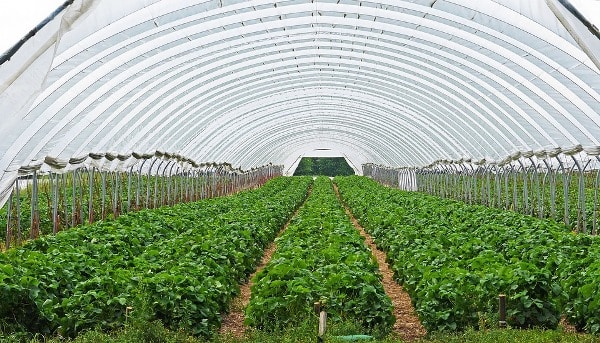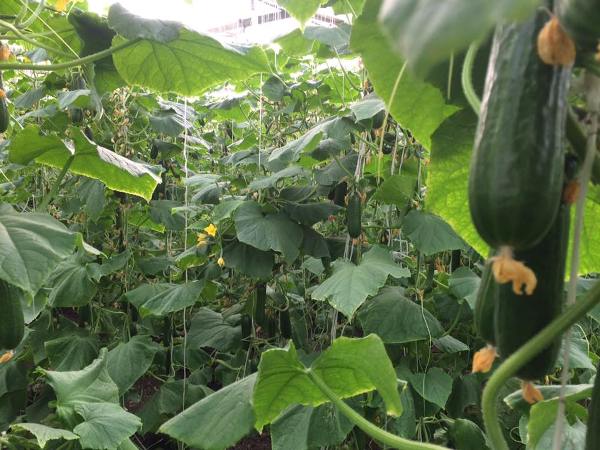Polyhouse Business Plan, Benefits, Construction Cost:
Today, let us discuss the Polyhouse Business Plan along with the construction cost and advantages of Polyhouse cultivation.
Introduction to Polyhouse Cultivation:
Many people are aware of cultivation in open fields, but not in protected environments like Polyhouse or greenhouse. You may question yourself, what is Polyhouse? Well, it is nothing but a framed structure covered with standard micron polythene sheets. You can grow crops like vegetables, flowers, ornamental plants, exotic fruits, nursery plants in a covered area with controlled conditions such as sunlight, irrigation, humidity, etc. However, some crops are not suitable for Polyhouse. Since there are many advantages of Polyhouse cultivation, many people already started growing suitable crops in a protected environment. If you are planning for an organic vegetable business or floriculture business, you should consider Polyhouse farming. Polyhouse cultivation works very well in areas nearer to local marketing centers or especially tier1 and tier2 cities. These places around the metro cities are now setting up with Polyhouse infra as it really increases the area of protected cultivation. Now deeply discuss How to plan for Polyhouse cultivation, Suitable crops for the Polyhouse environment, subsidies available for Polyhouse along with other information.

What Crops Can Be Grown in Polyhouse?
- Many vegetables such as colour capsicum, melons, cucumber, carrots, spinach, cilantro, mint, tomato, broccoli including any short-growing leafy vegetables and vines.
- Cut flowers/Ornamental flowers like Jasmine, Rose, Gerbera, Carnation, and
- Exotic fruits like strawberries.
- Herbal crops.
What are the Benefits of Polyhouse Cultivation and, why should one go for it?
- You can grow crops throughout the year without depending on the season.
- You can expect quality produce when compared to open field cultivation.
- There is much control of pests and diseases in the Polyhouse environment.
- One can expect a higher crop yield compared to open field cultivation.
- Soil erosion and water evaporation can be controlled in Polyhouse cultivation.
- Government assistance in getting subsidies, and loans from NABARD and Horticulture Department.
- Every year, there is an increase in demand for exotic varieties.
- You can produce and supply all around the year.
- You can utilize a cold storage facility for storing the produce.
- There is a good scope of the export business of these Polyhouse grown crops.
- There is a huge demand for produce in the offseason.

Polyhouse Construction Cost and ROI (Return on Investment)
Assumptions: (1 season): 6 months crop growing period.
Expenses for Polyhouse business plan requirements:
Cost of Polyhouse construction for the area of 600 sq.mts: Rs.4,00,000.
Seedlings/Saplings/Plant Mterials: Rs. 15,000.
Preparation of the soil and land: Rs. 25,000.
Set up of Drip Irrigation in Polyhouse: Rs. 50,000.
Cost of Pipeline: Rs. 1,25,000.
Manures and fertilizers: Rs. 25,000.
Pest control or pesticides: Rs. 4,000.
Power connection/Electricity: Rs. 5,000.
We have two types of costs involved in this. i.e. Fixed cost and Variable cost.
Fixed Cost Involved in Poluhouse Cultivation:
Let us list the fixed component details and their costs.
Cost of the structure: Rs. 4,00,000.
Cost of the drip system: Rs. 50,000.
Cost of the pipeline: Rs. 1,25,000.
Cost of the land preparation: Rs. 25,000.
Cost of Labour: Rs. 30,000.
Cost of Propagation Material: Rs. 15,000.
Insurance Premium: Rs. 8,000.
Total Fixed Cost: Rs. 6,53,000.
Variable Cost Involved In Polyhouse Cultivation
Let us list the variable component details and their costs
Cost of fertilizers and manures: Rs. 25,000.
Cost of Pesticides: Rs. 4,000.
Electricity charges: Rs. 5,000.
Packaging and Transport charges: Rs. 30,000.
Total Variable Cost: Rs. 64,000.
If you want to calculate the Return on investment (R.O.I), it depends on the total production of produce in the Polyhouse. The total profits from Polyhouse cultivation depend on many factors such as market demand, farm management practices, and type of crop grown.
You should use this formula in general to calculate R.O.I.
Total profit = Total Revenue – Total Expenses.
Return on Investment (R.O.I) = Total Profit/Total Expenses.
Usually, you can expect 30 to 35% of R.O.I in Polyhouse cultivation, if you have a good Polyhouse business plan.
We are not giving any special figures because we don’t know which crop we are planning to grow in Polyhouse. However, this gives an idea of growing expenses and profits in Polyhouse.
Polyhouse Cultivation is Profitable In these Conditions:
- If you set up Polyhouse nearby any cities where there is a good market for the produce.
- Good climatic conditions, and soil texture along with better irrigation facilities.
There are states in India, which are providing Polyhouse subsidy and for construction and other material. Even some states are providing up to 80% of subsidy. However, there is a minimum limit requirement of the Polyhouse setup area. You can avail complete information on Polyhouse Loan and Subsidy, you can see any technical officer in NABARD or Horticulture Department.
How much does it cost to set up a Polyhouse in 1 acre? Well, the total cost of 1 acre Polyhouse would be around Rs. 40 lakhs. If you get a subsidy of 80%, then you would be ending up paying 8 to 10 lakhs from your pocket.
The conclusion of Polyhouse Business Plan:
The typical Polyhouse areas are from 500 sq. meters to 20,000 sq. meters and these are suitable for small landholders. To be a successful Polyhouse farmer, you must have good skills in the construction of Polyhouse, crop growing techniques, and finally marketing the produce.
In case if you are interested in this: How To Grow Strawberries in Greenhouse.
- How to Make Houseplants Bushy: Effective Tips and Ideas
- Innovative Strategies for Boosting Coconut Pollination and Yield
- Pollination Strategies for Maximum Pumpkin Yield
- The Complete Guide to Chicken Fattening: Strategies for Maximum Growth
- Natural Solutions for Tulip Problems: 100% Effective Remedies for Leaf and Bulb-Related Issues
- Revolutionizing Citrus Preservation: Towards a Healthier, Greener Future
- Natural Solutions for Peony Leaf and Flower Problems: 100% Effective Remedies
- Maximizing Profits with Avocado Contract Farming in India: A Comprehensive Guide
- Natural Solutions for Hydrangea Problems: 100% Effective Remedies for Leaf and Flowers
- The Ultimate Guide to Choosing the Perfect Foliage Friend: Bringing Life Indoors
- From Sunlight to Sustainability: 15 Ways to Use Solar Technology in Agriculture
- The Ultimate Guide to Dong Tao Chicken: Exploring from History to Raising
- The Eco-Friendly Makeover: How to Convert Your Unused Swimming Pool into a Fish Pond
- Mastering the Art of Delaware Chicken Farming: Essentials for Healthy Backyard Flocks
- 20 Best Homemade Fertilizers for Money Plant: DIY Recipes and Application Methods
- How to Craft a Comprehensive Free-Range Chicken Farming Business Plan
- Brighten Your Flock: Raising Easter Egger Chickens for Beauty and Bounty
- How to Optimize Your Poultry Egg Farm Business Plan with These Strategies
- Subsidy for Spirulina Cultivation: How Indian Government Schemes Encouraging Spirulina Farmers
- Ultimate Guide to Raising Dominique Chickens: Breeding, Feeding, Egg-Production, and Care
- Mastering the Art of Raising Jersey Giant Chickens: Care, Feeding, and More
- Ultimate Guide to Raising Legbar Chickens: Breeding, Farming Practices, Diet, Egg-Production
- How to Raise Welsummer Chickens: A Comprehensive Guide for Beginners
- How to Protect Indoor Plants in Winter: A Comprehensive Guide
- Ultimate Guide to Grow Bag Gardening: Tips, Tricks, and Planting Ideas for Urban Gardeners
- Guide to Lotus Cultivation: How to Propagate, Plant, Grow, Care, Cost, and Profit
- Agriculture Drone Subsidy Scheme: Government Kisan Subsidy, License, and How to Apply Online
Agriculture forming construction business development consultant